A peek into designer HDB flats owned by interior designers
Professionals pull out all the stops and break convention when it comes to doing up their flats

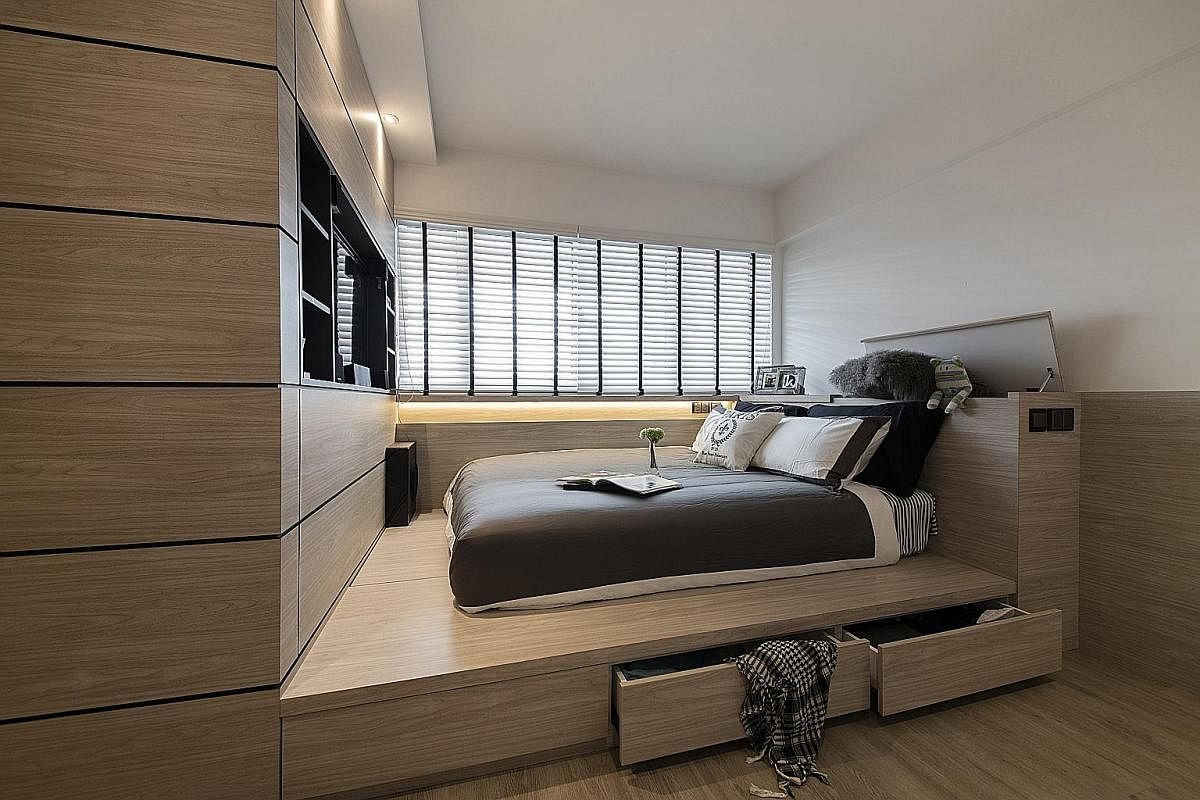
Glossy images of typical Housing Board flats made over into sleek stunners turn up regularly on social media feeds. These chic dwellings are often the work of interior designers who have a nose for style, but do they walk the talk themselves?
Three sets of interior designers open their homes to show how they overhauled their HDB flats into crisply tailored spaces.
They also share tips on what works and major no-nos.
One thing was for sure - they pulled out all the stops when it came to jazzing up their abodes.
Furnishing their first home in McNair Road, budding interior designer Vanessa Ong and her husband picked up decorative pieces on their travels. They chose minimalist fixtures for their light-filled flat.
Meanwhile, Mr Yeo See Wee and his wife JJ Yip of Wee Studio broke design rules and went with dark tones for the interiors of their Sengkang flat and a mirrored ceiling in their living room. The result is a dramatic home that feels like a cool lounge.
Mr Cameron Woo, the principal at his eponymous boutique interior design firm, says home owners have many inspiration avenues now, thanks to the Internet.
Mr Woo, who is the professional development programme chair at the Interior Design Confederation Singapore, says: "A decade ago, many of the interior design platforms did not exist. Access to information was limited to mainly design publications. The Internet and social media are the biggest influencers."
Mrs Chiquit Torrente-Brammall, the Singapore editor of Houzz, a platform for home renovation and design, agrees that much has changed in the interior design scene here. In part, design-savvy home owners see their homes as an extension of their personalities.
Mrs Torrente-Brammall, a trained architect who started covering home interiors as a magazine journalist 10 years ago, adds: "As today's HDB flats are designed to look less generic and have the mark of high-profile architects such as those from Woha and SCfDA, home owners feel better investing major money in renovating their apartments."
But there is so much to consider in designing an apartment, from budget to space planning, that buying the home seems like the easiest decision.
Besides tips from professionals on how to get started, interior design platforms such as Qanvast and Houzz weigh in with suggestions on what home owners should consider for their apartments.
Getting started: Tips from the professionals
What is your budget?
Get a handle on how much your renovation dream will cost you before you do the detailed planning.
A spokesman for Qanvast says that data collected by the interior design platform shows that home owners of new apartments spend between $30,000 and $60,000 on renovations while renovation costs for older, resale units start at $65,000.
Home owners need to have "a little leeway" in their budget and account for an excess of 10 to 20 per cent more than the original cost, he says. "It's common for home owners to spend more than their budget - upgrading to better tiles, adding carpentry work, or dealing with unexpected hiccups."
Ms Amy Picanco, a director at Aym Design and a council member of the Interior Design Confederation Singapore, says: "While it can be difficult, try to think long term - do you want a renovation that lasts for five or 10 years? This will affect the quality of the materials you use and may push prices up. However, it could save you a lot of time and money in the long run as it will be a lasting investment."
If you are engaging an interior designer or taking up a renovation package, do a background check on the company before handing over your money. Design platforms such as Qanvast and HomeRenoGuru suggest looking at online reviews of the company.
Home owners can also hire contractors with the CaseTrust Accreditation Mark, which means they are protected against closure of the business, and the HDB has a list of contractors under its Registered Renovation Contractors' Scheme that home owners can use.
Earlier this week, the Consumers Association of Singaporeraised concerns about the increased spending on renovation packages.
The renovation contractor industry has been in the consumer watchdog's top 10 list of industries with the highest number of complaints for the past decade.
Mr Morris Teo, managing director of HomeRenoGuru, a renovation website, says: "Home owners should be mindful when signing packages that appear very affordable. Reputable interior designers would usually include the entire renovation works in the initial contract.
"They should look out for clauses and contract details."
Home owners should also make sure they are getting good quality materials. Some interior designers charge extra if a home owner wants more than the basic offerings in the contract, he adds.
What look should you go for?
From industrial chic to Japanese minimalist, there are myriad styles to emulate.
Interior designer and founder of Wee Studio, Mr Yeo See Wee, suggests that home owners create a lookbook with images of a few things they like. Avoid cluttering the concept with tons of ideas.
"If you have 10,000 pictures of every style, that makes it very difficult for you and your interior designer to decide what style to go with."
Architecturally trained interior designer Vanessa Ong gives this tip: limit the colour and texture tones to four or five options. Keep it simple, she says, as "over-designing doesn't necessarily mean good design".
Ms Ong, who recently completed renovating her own Build-To-Order flat, adds: "Take time to observe spaces, objects, textures that inspire you or places you've visited. Your home should tell a story of who you are."
To hack or not to hack?
Open-concept homes are all the rage. Knocking down walls creates seamless spaces and makes a flat look bigger.
But first, you will need to get approval from HDB before any walls can be demolished. HDB will check if removing these walls would affect the structural integrity of the building.
The Qanvast spokesman suggests considering the reason for pulling down the wall. For example, if a couple is planning to have children, keeping the walls to an extra bedroom might be prudent.
He says: "Home owners should think about how long they'll be staying in the flat and what their plans for the future are so that the flat can provide for their future needs. Erecting a wall in the future will be an unnecessary, time-consuming and costly endeavour."
How much space to use?
With home owners moving into smaller digs, clever space planning is needed.
Mrs Chiquit Torrente-Brammall says she has picked up tips from architects and designers she has worked with. Ms Gwen Tan of Formwerkz Architects says home owners should plan for more storage for future possessions.
From head stylist Caroline Chin-Geyler of interior decorating firm Arete Culture, Ms Torrente- Brammall says she learnt to "think tall when small". That means building storage upwards, utilising vertical surfaces, and mounting electronics and lighting on walls.
HomeRenoGuru's Mr Teo says that first-time home owners often underestimate the storage space they need. They need to plan with the future in mind, he says.
Interior designers suggest incorporating built-in storage. For example, having floor-to-ceiling shelves to maximise wall space, or opting for beds with storage beneath them.
How to create a private nook?
Many apartments in older flats tend to be along common corridors - which means you hear everything that happens outside your windows. Nosy neighbours can also peek in anytime.
One clever idea by Elpis Interior Design is to erect a "half-wall" that offers privacy and still lets light in. To make full use of the wall, mount a television on it.
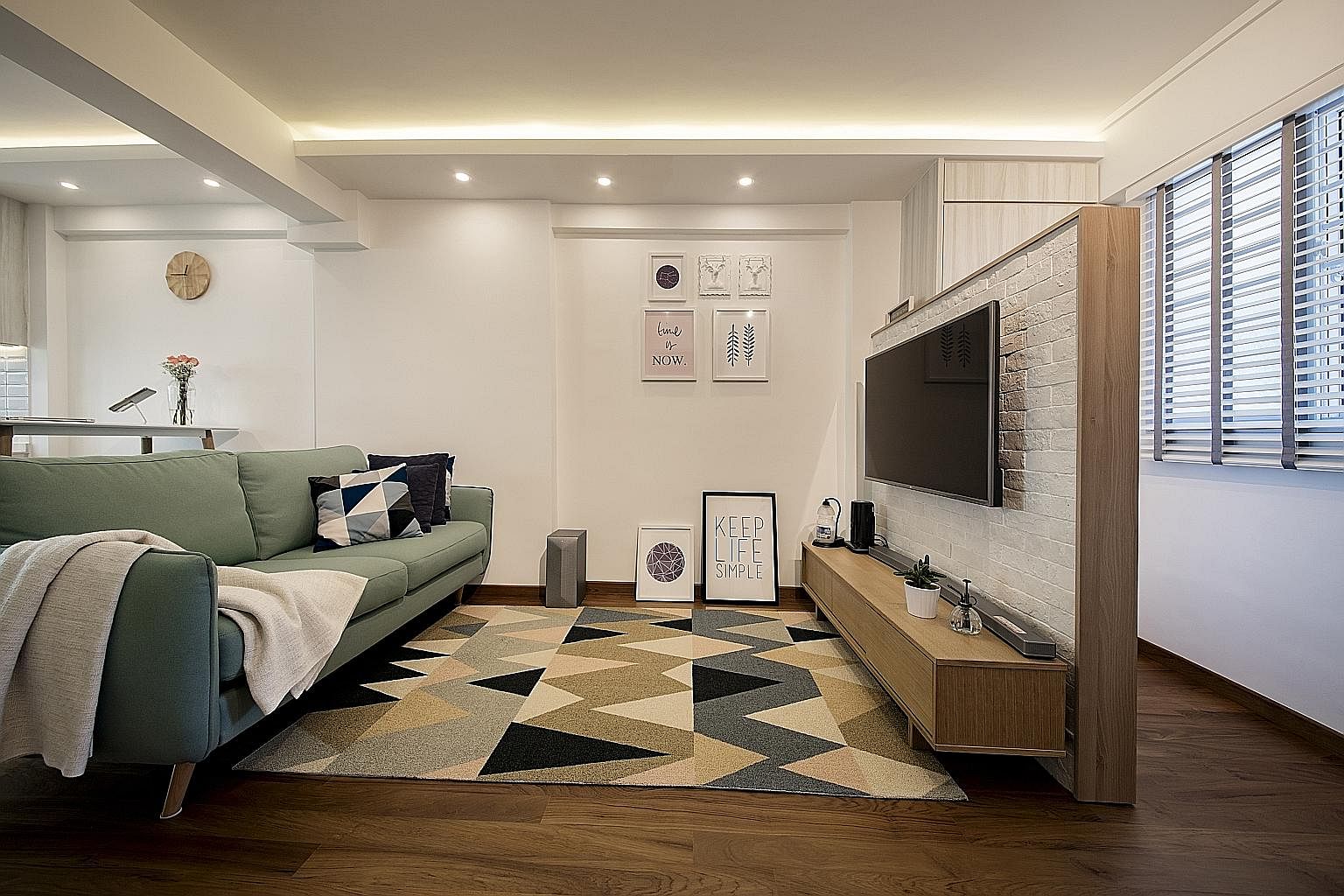
Aym Design's Ms Picanco says one can consider hanging heavy fabric curtains on windows that face a walkway. She also points to innovative products such as acoustic films which can be applied to glass to increase sound proofing.
She says: "Privacy at home is invaluable - we all want to feel a sense of retreat when we walk in the door."
Natural light adds warmth
With their Build-To-Order flat on the second floor facing other Housing Board blocks, couple Vanessa Ong and Nigel Chan found that parts of their house could be quite dark.
In the original layout of the four-room flat, a few of the walls prevented sunlight from reaching the deeper recesses of the house, such as the kitchen.
Their solution: knock down some of the walls in the kitchen and replace the brick wall of one room with a sliding door.
Ms Ong, 31, who owns interior design company April Atelier, says: "Our priority was to bring natural light into the house. It gives you a feeling of warmth."
And instead of going with funky colours for each room, they kept the walls mostly white. Besides making the home look brighter, this allows the furniture and decorative accents to pop.
Ms Ong suggests choosing just four to five colours or texture tones and playing around with different materials instead.
The main colours in this flat are grey, black and white. There are also brass accents from decor pieces such as lights and a table top. Plants provide touches of green.
Ms Ong, who is architecturally trained, says: "By restricting the palette, you get simplicity. Adding lots of things in doesn't mean better design."
The couple spent about $80,000 on renovations, excluding the furniture, fittings and appliances. They moved into the 990 sq ft apartment about three months ago. Mr Chan, 31, is a ship broker.
The couple picked up furnishings on their trips. These included tableware from Sri Lanka, taps from Australia and art from New York.
Ms Ong says: "We didn't stick to a particular style. We wanted our home to be a reflection of the things we like."
Invest in quality furniture
The first thing that catches your eye in Ms Molina Hun and Mr Sujono Lim's flat at The Pinnacle@Duxton is a 2.85m-long matte black table seemingly floating between two terazzo plinths.
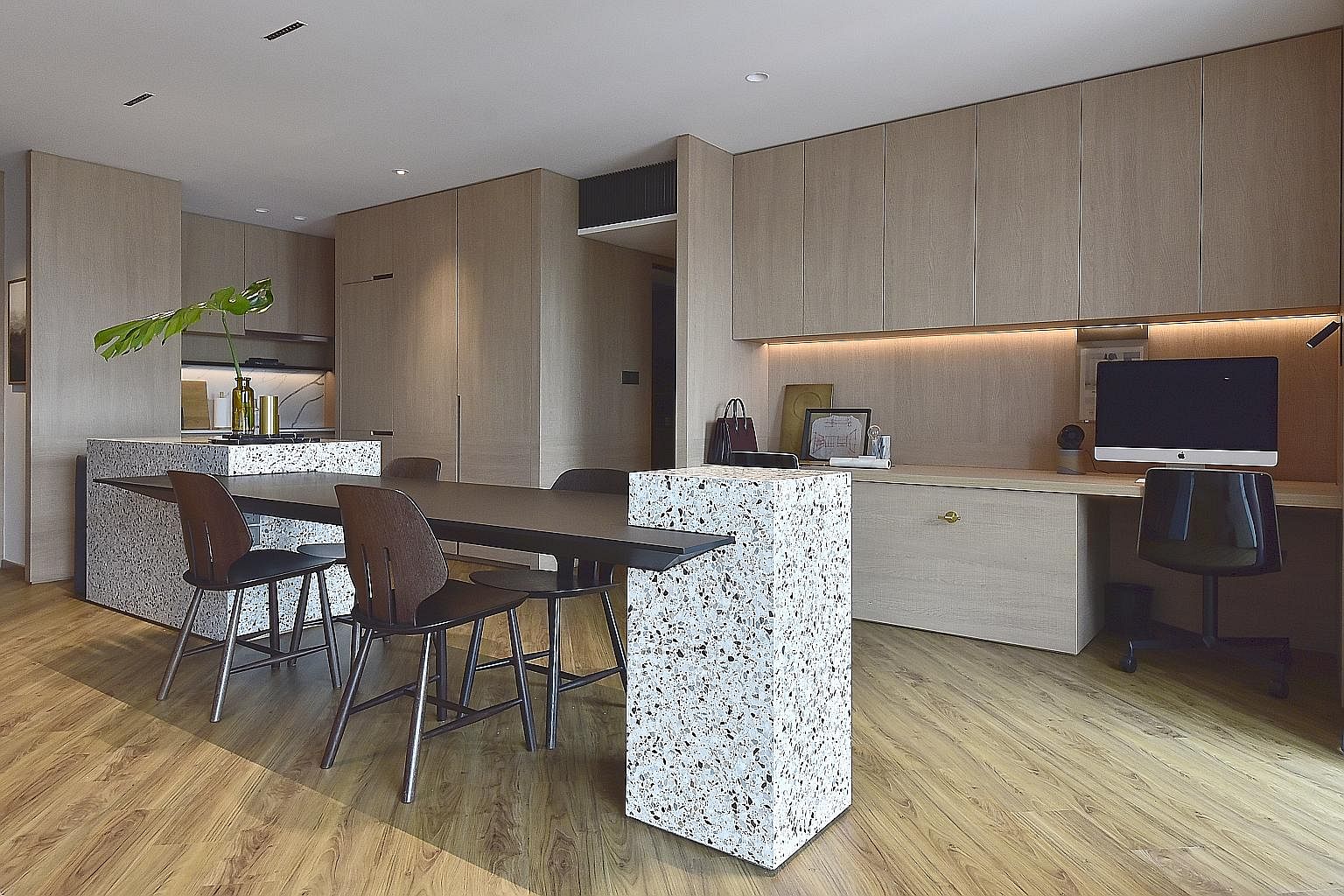
The dining table is a multi-functional piece that dominates the 1,022 sq ft home. Besides being a spot where the couple work and eat, it separates the living room from the work nook and the bedrooms at the back of the house.
It is not the typical layout in which home owners play up the living room and segregate spaces more distinctly.
But Mr Lim says they started by looking at their lifestyle and taking stock of how they planned to use the space - something he encourages home owners to do instead of following a set layout template.
The couple run Sujonohun, a multi-disciplinary design practice, and Ms Hun uses the home as an office to meet clients.
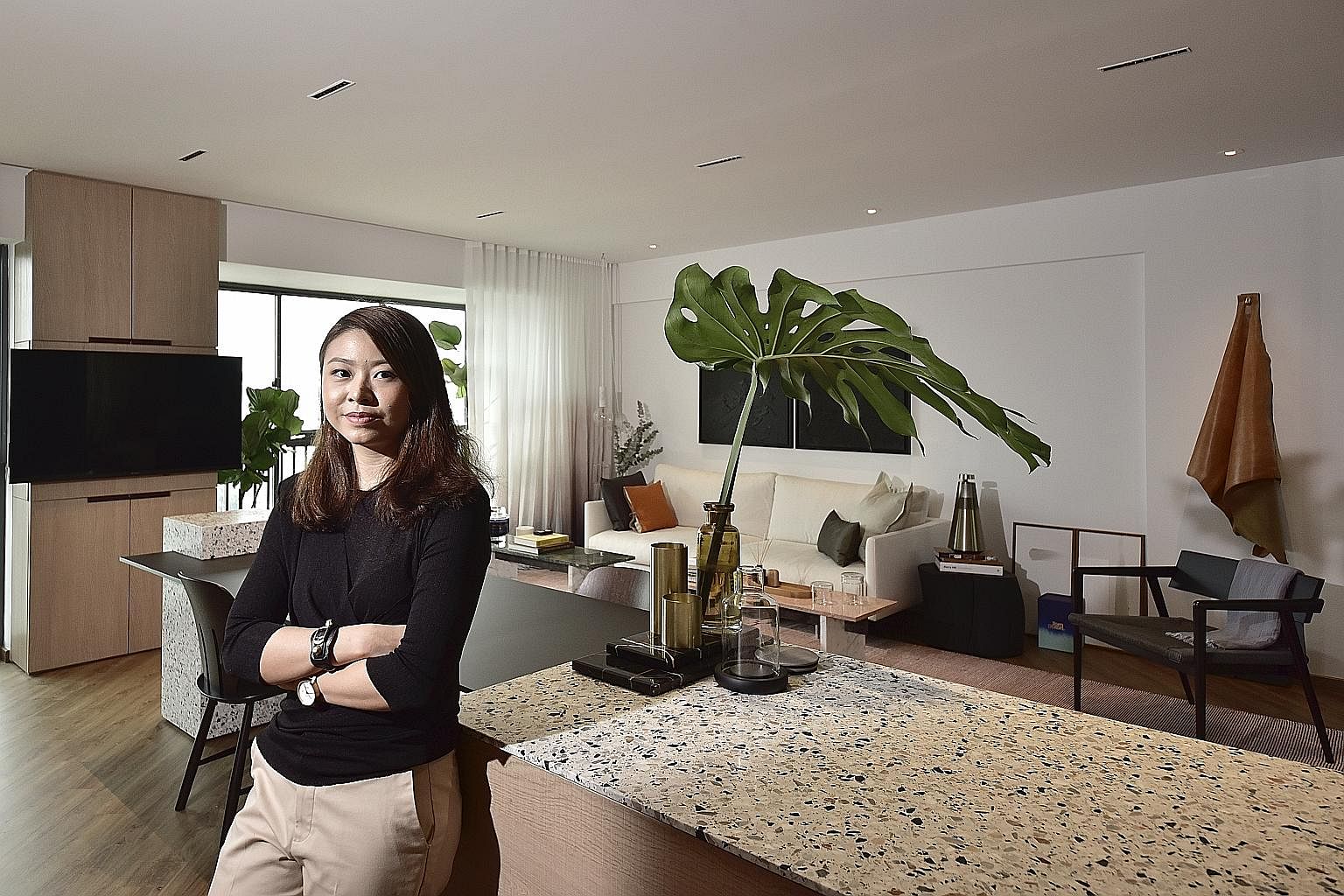
Mr Lim, 28, the studio's principal director, says: "Dinner time is the most important part of our day. It is when we meet to eat after a long day and chat with each other."
The dining table takes centre stage because of these meals together. They also entertain friends around it, and Ms Hun sometimes discusses plans with clients there.
They found no need to install a television console in front of a sofa set. Instead, a rotational television is mounted on a wall facing the dining table.
The couple, who have no children, also opted for a smaller wet kitchen because they do not cook often and created a pantry that could be hidden behind doors - a quick fix for when clients come by and they want to hide the mess.
They shipped in products such as gold dimmer switches from London home fashion label Buster + Punch.
Other interesting pieces: two marble coffee tables in the living room. One has a dark green table top, while the other is an orange-pink pastel shade. They found the tables at a local marble showroom.
The resale flat is the couple's first home, and it took about 2½ months to complete the $80,000 renovation. The cost includes appliances, but excludes furnishings and fixtures.
To them, the furniture is an investment as they intend to keep it for a long time.
Ms Hun, 28, the creative director at the studio and an adjunct lecturer at Lasalle College of the Arts, says home owners should set aside a budget for good furniture pieces. "Instead of buying cheap furniture that may not last, choose pieces that can move with you to your next home."
Test bed for bold ideas
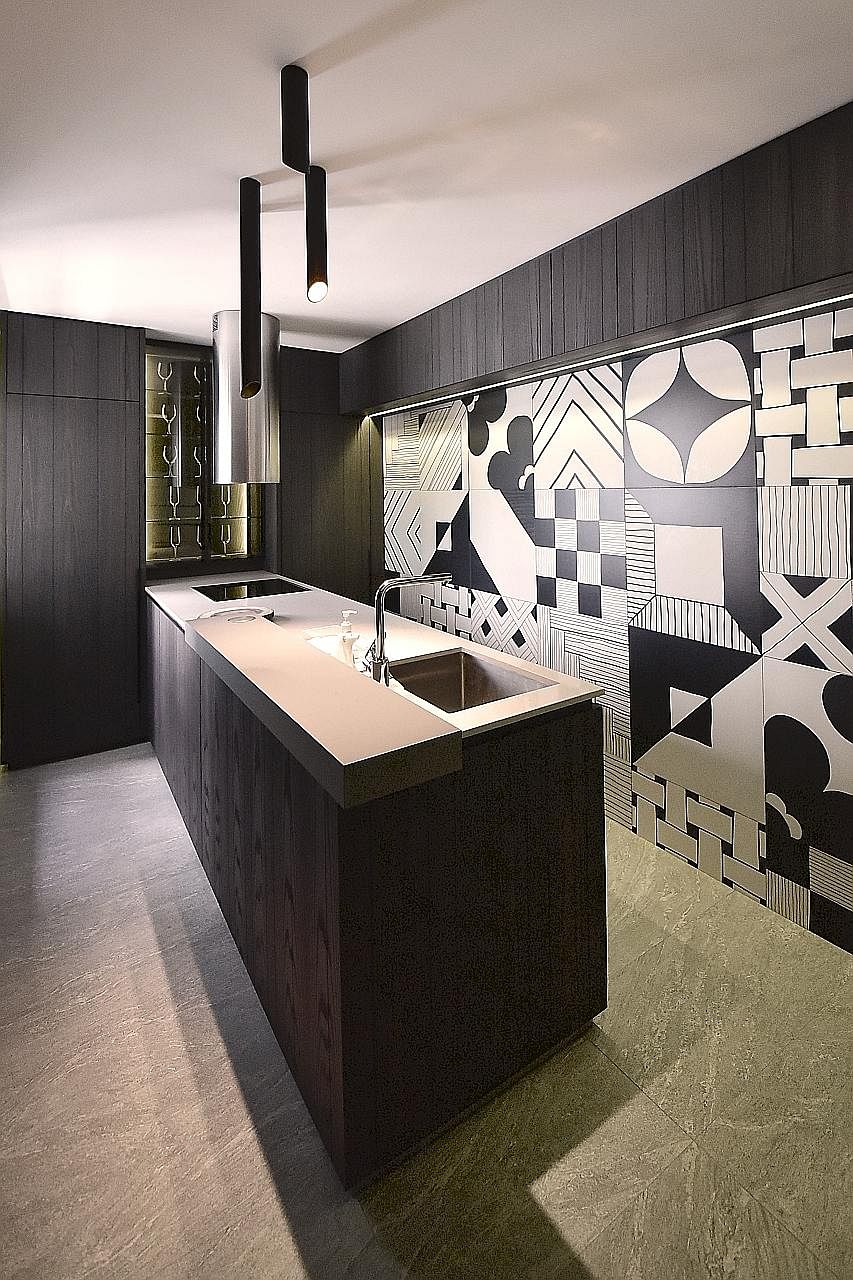
Interior designers Yeo See Wee, 32, and JJ Yip, 28, of Wee Studio, try to push boundaries with their design proposals, at times including bold or untested ideas.
Conservative clients typically veto such suggestions.
So when it came to designing their five-room Housing Board flat in Sengkang, their unrealised concepts came in handy.
The 1,300 sq ft flat became a laboratory for the newly-wed couple to test out their unconventional ideas.
For starters, their home is a dramatic ode to a dark palette of grey and black hues, breaking traditional decor rules of choosing bright colours to create an airy space. This look, Ms Yip says, works for homes with lots of light coming through. But, she warns, interiors like this may mean more cleaning, as dust shows easily on dark surfaces.
In their home there is a mirrored ceiling above the sofa and coffee tables in the living room that creates the illusion of a higher ceiling.
The original master bedroom and another bedroom were combined to create a larger space that can fit more than just a bed.
A work desk was built in front of the window. There is a spacious walk-in wardrobe with a jewellery display island. The couple also drew inspiration from hotel rooms and included a small pantry.
And instead of a folding or sliding door for the bathroom, Mr Yeo decided to go with a large pivot door - a fixture not often seen in homes as the door is heavy.
Other bold touches include hand-drawn Italian tiles with busy patterns that line the communal floor area. These are also used to create a feature wall in the kitchen.
The remaining room is used as a guest bedroom.
The couple, who moved into their home last year, say that the house is not child-friendly but fits their lifestyle.
Mr Yeo, who founded the studio about six years ago, says: "Not many people would go for this look. It's like a hotel for us - we don't spend a lot of time here. It's where we come to relax and hang out."
Still, there are ideas to steal from this sophisticated home.
For one thing, it is hard to tell that the couple have lots of stuff. Everything from clothes to appliances are hidden behind cupboards and drawers.
They also hide the bolts and nuts, such as sliding door tracks and do away with regular handles for doors and cabinets, so surfaces look seamless.
The couple decline to reveal the total cost of their renovation and say it is on the "high side".
Going by the result, they say it is money well spent. Mr Yeo says: "We're going to be living here for a long time, so we decided to invest in our home."
Join ST's Telegram channel and get the latest breaking news delivered to you.
A version of this article appeared in the print edition of The Straits Times on September 02, 2017, with the headline A peek into designer HDB flats owned by interior designers. Subscribe

